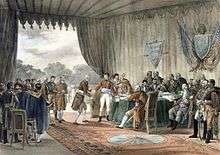1800 in the United States
| 1800 in the United States | |
|---|---|
| Years: | 1797 1798 1799 – 1800 – 1801 1802 1803 |
|
| |
 The Star Spangled Banner, 15 stars, 15 stripes (1795–1818) | |
|
Timeline of United States history
| |
Events from the year 1800 in the United States.
Incumbents
Federal Government
- President: John Adams (F-Massachusetts)
- Vice President: Thomas Jefferson (DR-Virginia)
- Chief Justice: Oliver Ellsworth (Connecticut)
- Speaker of the House of Representatives: Theodore Sedgwick (F-Massachusetts)
- Congress: 6th
Events

September 30: Treaty of Mortefontaine signed
- January 7 – The Virginia General Assembly adopts the Report of 1800, a resolution drafted by James Madison arguing for the sovereignty of the individual states under the United States Constitution and against the Alien and Sedition Acts.
- April – Voting begins in the United States presidential election, 1800; it will last until October. The result is not announced until February 1801.
- April 24 – The U.S. Library of Congress is founded.
- May 21 – President John Adams issues general amnesty for the Pennsylvania Dutch farmers who participated in Fries's Rebellion.
- July 4 – Indiana Territory is formed by an Act of Congress as the first new territory created from the lands of the Northwest Territory.
- July 10 – Connecticut cedes its Western Reserve (an area in present-day northeastern Ohio) to the federal government, which adds it to the Northwest Territory.
- August 4 – The 2nd United States Census is conducted. It finds 5,308,483 people living in the U.S. of which 893,602 are slaves.
- August 30 – Gabriel Prosser's slave revolt in Richmond, Virginia is postponed due to weather. Word of his plan reaches Virginia's governor, James Monroe, who calls in the state militia. Gabriel is later captured and hanged on October 10 along with 23 other slaves.
- September 30 – The Convention of 1800, or Treaty of Mortefontaine, is signed between France and the United States of America, ending the Quasi-War.
- October 1 – In the Third Treaty of San Ildefonso, Spain returns Louisiana to France.
- November 1
- U.S. President John Adams becomes the first President of the United States to live in the Executive Mansion (later renamed the White House).
- Middlebury College is granted its charter by the Vermont General Assembly.
- November 17 – The U.S. Congress holds its first Washington, D.C. session.
Ongoing
- Quasi-War (1798–1800)
Publications
- "Parson" Weems' A History of the Life and Death, Virtues and Exploits of General George Washington.
Births
- January 7 – Millard Fillmore, 13th President of the United States from 1850 till 1853, 12th Vice President of the United States from 1849 till 1850. (died in 1874)
- February 26 – Lucius Lyon, United States Senator from Michigan from 1843 till 1845. (died 1851)
- May 9 – John Brown, abolitionist (died 1859)
- July 15 – Sidney Breese, United States Senator from Illinois from 1843 till 1849. (died 1878)
- October 2 – Nat Turner, leader of slave rebellion (died 1831)
- October 3 – George Bancroft, historian (died 1891)
- October 30 – David Meriwether, United States Senator from Kentucky in 1852. (died 1893)
- December 29 – Charles Goodyear, inventor (died 1860)
Deaths
- January 20 - Thomas Mifflin major general in the Continental Army, President of the Continental Congress, signatory of the Continental Association (born 1744)
- March 21 – William Blount, politician (born 1749)
- October 28 – Artemas Ward, Major General of the Continental Army and politician (born 1727)
External links
-
 Media related to 1800 in the United States at Wikimedia Commons
Media related to 1800 in the United States at Wikimedia Commons
This article is issued from Wikipedia - version of the 11/11/2016. The text is available under the Creative Commons Attribution/Share Alike but additional terms may apply for the media files.